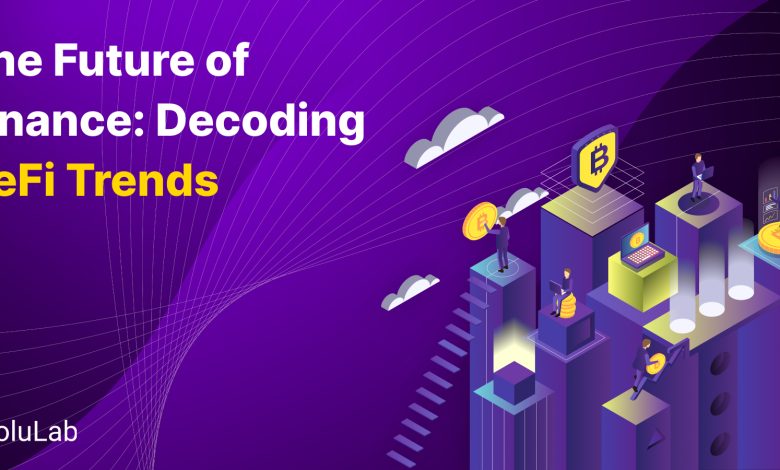The Future of DeFi: Trends and Predictions

- Understanding the current landscape of DeFi
- Emerging trends in decentralized finance
- Challenges and opportunities in the DeFi space
- Predictions for the future of decentralized finance
- The role of regulation in shaping the future of DeFi
- Innovations driving the evolution of DeFi
Understanding the current landscape of DeFi
As we look at the current landscape of decentralized finance (DeFi), it is evident that the industry has experienced tremendous growth and innovation in recent years. DeFi platforms have emerged as a viable alternative to traditional financial systems, offering users the ability to access a wide range of financial services without the need for intermediaries.
One of the key trends in the DeFi space is the rise of decentralized exchanges (DEXs), which allow users to trade cryptocurrencies directly with one another without the need for a centralized exchange. This has led to increased liquidity and trading volumes in the DeFi market, making it more attractive to both retail and institutional investors.
Another important development in the DeFi landscape is the emergence of decentralized lending and borrowing platforms. These platforms allow users to lend out their cryptocurrencies and earn interest on their holdings, or borrow assets by using their existing holdings as collateral. This has opened up new opportunities for users to earn passive income and access liquidity without relying on traditional financial institutions.
Overall, the current landscape of DeFi is characterized by innovation, growth, and increasing adoption. As more users and developers flock to the space, we can expect to see even more exciting developments and opportunities in the future.
Emerging trends in decentralized finance
Decentralized finance (DeFi) is a rapidly evolving sector within the cryptocurrency industry, with new trends emerging regularly. Keeping up with these trends is crucial for investors and developers looking to stay ahead of the curve. Some of the emerging trends in DeFi include:
- 1. **Interoperability**: One of the key trends in DeFi is the push towards interoperability between different blockchain networks. This allows for seamless communication and transfer of assets between various platforms, enhancing the overall user experience.
- 2. **Liquidity mining**: Liquidity mining, also known as yield farming, has gained popularity in DeFi circles. Users can earn rewards by providing liquidity to decentralized exchanges and other platforms, incentivizing participation in the ecosystem.
- 3. **Cross-chain solutions**: As the DeFi space continues to grow, there is a need for cross-chain solutions that enable assets to move between different blockchains. Projects working on interoperability are gaining traction as a result.
- 4. **Decentralized autonomous organizations (DAOs)**: DAOs are another emerging trend in DeFi, allowing for decentralized governance and decision-making within a project or platform. This gives users more control over the direction of the ecosystem.
- 5. **Layer 2 scaling solutions**: With the increasing popularity of DeFi applications, scalability has become a pressing issue. Layer 2 scaling solutions aim to address this by offloading transactions from the main blockchain, reducing congestion and fees.
These trends are shaping the future of DeFi and are likely to have a significant impact on the industry in the coming years. By staying informed and adapting to these changes, stakeholders can position themselves for success in the rapidly evolving world of decentralized finance.
Challenges and opportunities in the DeFi space
As the decentralized finance (DeFi) space continues to grow rapidly, it presents both challenges and opportunities for participants in the ecosystem. One of the main challenges facing DeFi is the issue of security. With the increasing number of hacks and exploits targeting DeFi protocols, there is a pressing need for better security measures to protect users’ funds.
On the other hand, the DeFi space also offers numerous opportunities for innovation and growth. The ability to access financial services without the need for traditional intermediaries has the potential to revolutionize the way we think about finance. DeFi also opens up new possibilities for financial inclusion, allowing individuals who were previously excluded from the traditional financial system to participate in global markets.
Another challenge in the DeFi space is the issue of scalability. As more users flock to DeFi platforms, the network congestion and high transaction fees on the Ethereum blockchain have become major pain points. This has led to the exploration of layer 2 solutions and alternative blockchains to address these scalability issues.
Despite these challenges, the future of DeFi looks promising. With ongoing research and development efforts focused on improving security, scalability, and user experience, the DeFi ecosystem is poised for continued growth and innovation. As more projects enter the space and new use cases emerge, the potential for DeFi to disrupt traditional finance and create a more inclusive financial system is becoming increasingly apparent.
Predictions for the future of decentralized finance
When looking at the future of decentralized finance (DeFi), there are several trends and predictions that experts are considering. One of the key predictions is the continued growth of DeFi platforms, as more users become aware of the benefits of decentralized financial services. This growth is expected to lead to increased adoption of DeFi solutions across various industries, including banking, insurance, and real estate.
Another prediction for the future of DeFi is the development of more sophisticated financial products and services. As the technology behind DeFi continues to evolve, we can expect to see new and innovative ways to access and manage financial assets. This could include the creation of decentralized lending platforms, automated trading systems, and even decentralized insurance products.
Furthermore, experts predict that regulatory frameworks will play a crucial role in shaping the future of DeFi. As governments around the world start to pay more attention to decentralized finance, we can expect to see new regulations put in place to protect consumers and ensure the stability of the financial system. This could lead to a more mature and secure DeFi ecosystem in the long run.
The role of regulation in shaping the future of DeFi
Regulation plays a crucial role in shaping the future of decentralized finance (DeFi). As the DeFi space continues to grow rapidly, regulators around the world are starting to take notice and consider how to best oversee this innovative sector. The regulatory environment will have a significant impact on the development and adoption of DeFi platforms and applications.
Regulation can provide much-needed clarity and legitimacy to the DeFi industry, making it more attractive to traditional investors and institutions. However, overly restrictive regulations could stifle innovation and drive DeFi projects underground. Striking the right balance between protecting consumers and fostering innovation will be key to the long-term success of DeFi.
Regulators are faced with the challenge of understanding and adapting to the unique characteristics of DeFi, such as its decentralized nature and automated processes. They must find ways to address concerns around security, privacy, and compliance without stifling innovation. Collaboration between regulators, industry participants, and other stakeholders will be essential to developing effective regulatory frameworks for DeFi.
Innovations driving the evolution of DeFi
Several innovations are propelling the evolution of DeFi, transforming the landscape of decentralized finance. These advancements are reshaping the way users interact with financial services, offering new opportunities for growth and development.
One of the key innovations driving the evolution of DeFi is the rise of decentralized exchanges (DEXs). These platforms allow users to trade cryptocurrencies directly with one another, without the need for a centralized intermediary. This peer-to-peer trading model offers increased security, transparency, and control over assets, making it an attractive option for many DeFi users.
Another significant development in the DeFi space is the emergence of decentralized lending and borrowing protocols. These platforms enable users to lend out their assets to earn interest or borrow assets by providing collateral. By cutting out traditional financial institutions, decentralized lending and borrowing protocols offer lower fees, faster transactions, and greater accessibility to financial services.
Smart contracts are also playing a crucial role in driving the evolution of DeFi. These self-executing contracts are coded to automatically enforce and execute the terms of an agreement when certain conditions are met. Smart contracts enable the creation of complex financial instruments, such as decentralized derivatives and automated market makers, which are revolutionizing the DeFi ecosystem.
Furthermore, the integration of oracles in DeFi is opening up new possibilities for accessing real-world data on the blockchain. Oracles provide external information to smart contracts, enabling them to interact with off-chain data sources. This integration is essential for powering decentralized prediction markets, insurance protocols, and other DeFi applications that require real-time data feeds.




